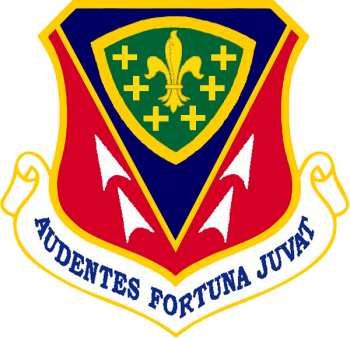366th Fighter Wing, US Air Force: Difference between revisions
Knorrepoes (talk | contribs) m (Text replacement - "{| class="wikitable"↵|+Official blazon↵|-↵|'''English''' ↵| (wanted)↵|}" to "{| class="wikitable" |+Official blazon |- |'''English''' | blazon wanted |}") |
Knorrepoes (talk | contribs) m (Text replacement - "↵↵↵Literature" to " Literature") |
||
| Line 16: | Line 16: | ||
===Origin/meaning=== | ===Origin/meaning=== | ||
The Emblem was approved on 3 August 1965. | The Emblem was approved on 3 August 1965. | ||
[[Literature]]: Image from Wikimedia Commons | [[Literature]]: Image from Wikimedia Commons | ||
Revision as of 19:02, 20 August 2023
366TH FIGHTER WING, US AIR FORCE
History: Established as 366th Fighter-Bomber Wing on 15 November 1952. Activated on 1 January 1953. Redesignated as 366 Tactical Fighter Wing on 1 July 1958. Inactivated on 1 April 1959. Activated on 30 April 1962. Organized on 8 May 1962. Redesignated as 366 Wing on 1 October 1991; 366 Fighter Wing on 30 September 2002. Replaced the 132 Fighter-Bomber Wing when activated in January 1953. Trained to maintain combat proficiency. Conducted air refueling, September 1954– July 1958. Rotated tactical squadrons to France, 1954–1956, and to Italy, 1955–1957. Served as conventional strike force in Europe, 1962–1963. Moved to the United States in July 1963 and converted to F–4 aircraft in 1965. Moved to Phan Rang AB, South Vietnam, in March 1966 for combat operations. In addition to its F–4 squadrons, also controlled several F–100 squadrons in 1966. In 10 October 1966, wing designation moved “on paper” to Da Nang AB, South Vietnam, giving the 366th new personnel, equipment, and facilities. By early 1967, many of the wing’s combat missions involved flying cover for F–105 strike aircraft, offering numerous opportunities for aerial combat with North Vietnamese MiG aircraft. Wing pilots scored 18 aerial victories in Southeast Asia. In 1972, gained a squadron with an electronic countermeasures mission and another with a forward air control mission. Moved to Thailand in Jun 1972 with little change in combat missions but flew only F–4s. Moved without personnel or equipment to the United States in October 1972 to replace the 347 Tactical Fighter Wing at Mountain Home AFB. The 366th become operational with F–111F aircraft. In 1977, in a three-way switch of aircraft, transferred F–111Fs to a wing in England and gained F–111A aircraft from a wing at Nellis AFB, NV. Thereafter, in addition to a wartime strike/interdiction mission, the wing also trained replacement aircrews for the USAF’s F–111A community. Acquired electronics countermeasures capabilities with addition of EF–111A radar jamming aircraft in late 1981. Operated an electronic combat range and provided mobile electronic range support for exercises held by other units. In December 1989, deployed EF–111A aircraft to support to USAF units involved in the invasion of Panama. The 366th also deployed EF–111A aircraft and maintenance support personnel to Saudi Arabia in August–September 1990, and it conducted extensive electronic warfare operations in Southwest Asia. In the summer of 1991, the wing relinquished its F–111A aircraft and the accompanying replacement crew training role; its complement of EF–111A aircraft departed the following year. In the meantime, the 366th transitioned to the composite wing concept, beginning with the introduction of F–16C/D fighter and F–15E strike fighter aircraft in the fall of 1991, adding F–15C fighters and KC–135R tankers in mid-1992. A squadron of B–52G bombers was also assigned in July 1992, and these in turn were replace by B-1B bombers in 1994. Regularly deployed expeditionary forces to contingencies in Southeast Asia such as operations SOUTHERN WATCH and DESERT STRIKE. Deployed three squadrons and a base support element to the CENTCOM theater to participate in Operations ENDURING FREEDOM after the 11 September 2001 terrorist attacks, as well as providing combat air patrol and air refueling assets in support of Operation NOBLE EAGLE. Wing’s mission narrowed to a fighter role in 2002.
| English | blazon wanted |
Origin/meaning
The Emblem was approved on 3 August 1965. Literature: Image from Wikimedia Commons
. Information from https://www.afhra.af.mil/
